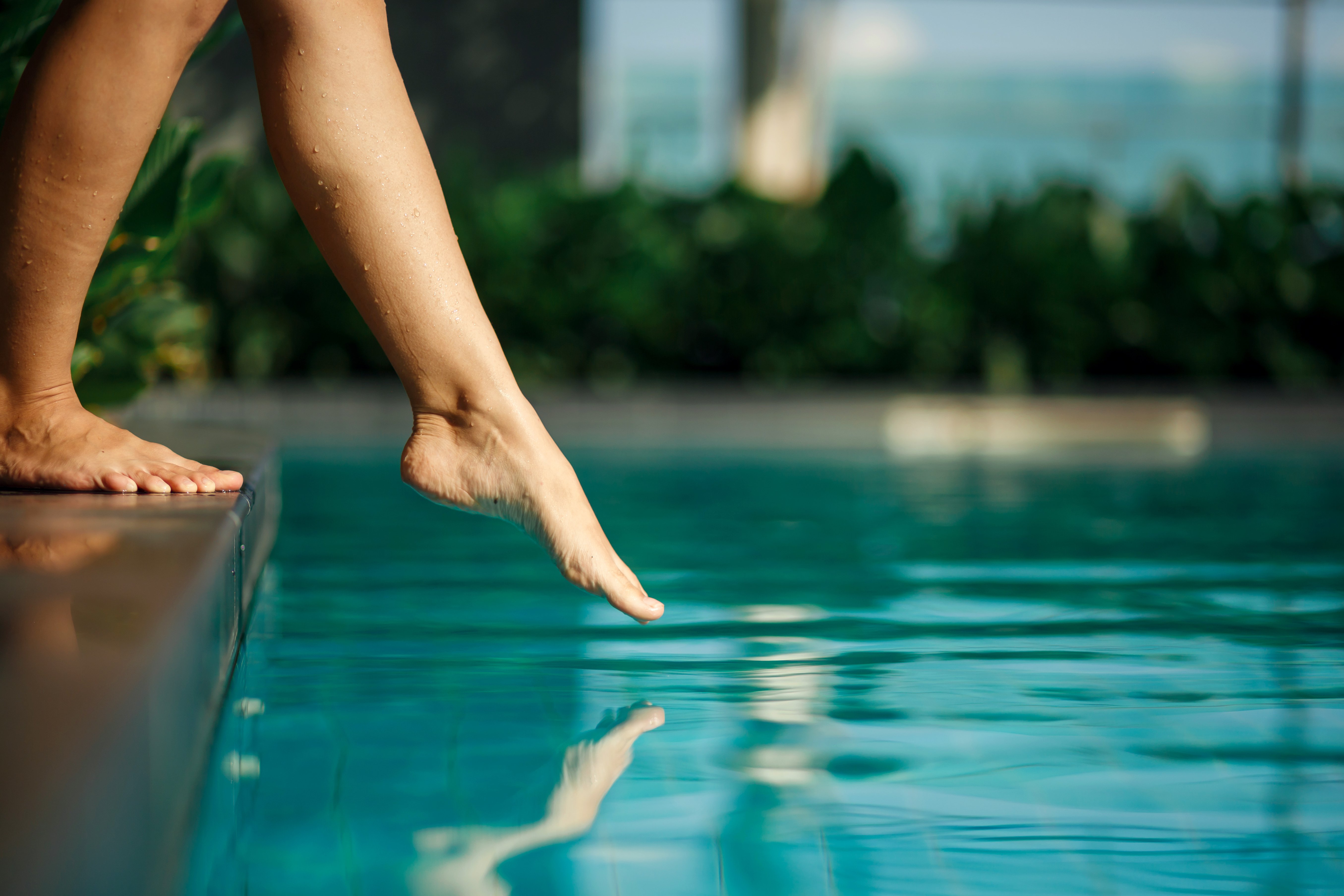How Much Does it Cost to Heat a Pool?
The cost to heat a swimming pool is a hot topic (pun intended!). It seems a little weird to spend so much on a pool and only use it for 3 months a year, doesn't it? So, is gas pool heating better than an electric heat pump? What about solar heating? What costs more to run? More importantly, how do you decide the best option for you and your budget? Let's talk about all that and sum it up with running costs to make it easy!
Not many people pay $25,000 for a car and only use it for 3 months a year. Yet when it comes to pools, we spend more than $25,000 and use it for around 3 months a year between December and February. It certainly costs money to heat your pool however, doubling the number of months your pool is used each year can be a pretty good return on investment.
There are plenty of variables that determine which pool heater you need and it's not just the amount of water your pool holds. Whether you will use a pool blanket, where in Australia you live, how many hours a day your pool is shaded, wind exposure and the water temperature you want, impacts hugely on the type of heater you will need to do the right job and the running costs over the next 10 years.
It is also tempting to go for the smallest unit you "can get away with" which was a regrettable approach I took many years ago. Think of it like towing a caravan. You can get away with using an underpowered small car. However, the engine will struggle at maximum power, you will use a massive amount of fuel and rack up constant repair bills. Or, you use the right size car with enough power to tow the caravan comfortably. The engine is working in a fuel-efficient mid-range and you won't wear the car out, leading to lower running and repair costs.
First things first. Let's answer the following as a starting point - How do you want to use your pool once it is heated?
- Extending The Swimming Season - "We'd like to start using the pool in spring and still be swimming well into autumn" is a comment I always hear. The goal is to take the edge off the chilly water by heating your pool to between 26 to 30 degrees Celsius (°C). This is what we mean by extending the swimming season. As the good 'ol sun is starting to warm up your pool water after winter, you can use a smaller unit to heat your pool compared to if you want to heat your pool in the middle of winter when the air and water temperatures are so much colder. As you are potentially using your heater for the months on either side of summer, the running costs are pretty low.
- Year-Round Swimming - "I want to be able to do laps in the middle of winter and have my pool ready to go". This is heating for year-round swimming. When it is 12°C outside and your pool water temperature is 30°C, it will feel like a warm bath so it's not as crazy as it sounds. That said, having an honest chat with yourself about how often you will be keen to go swimming when it's cold, windy and raining might keep a few thousand bucks in your back pocket. Still keen? Ok, keeping a pool heated through winter requires a higher output heater, given the natural water temperature in your pool is so much lower in winter. A bigger heater costs more to buy and run each year.
Do I Need A Pool Blanket To Heat My Pool?
This is similar to being asked "Would you like another glass of wine?". You know you shouldn't however it is just so tempting to think it won't make any difference in the morning! So, you kind of know you should have a pool blanket....right? Yes, I know, they don't win any beauty contest unless you go for an inground box or combined bench seat and roller unit which hides the blanket.
Pool water generally attempts to drop to ambient air temperature overnight which is when you lose the most heat from your pool. Spring and autumn is the time when it can be a sunny 22°C during the day and still as low as 10°C at night. Let's say the overnight temperature is 16°C and you're heating your pool during the day to 28°C. Let's compare what happens overnight with and without a pool blanket:
- Overnight Pool Temperature Drop Without A Pool Blanket - up to 8°C (10+°C if it is windy)
- Overnight Pool Temperature Drop With A Pool Blanket - up to 2°C
A pool blanket will also naturally heat your pool water by up to 8°C which reduces how many heater running hours you need to hit your ideal temperature. A starting water temperature of 22°C is considerably cheaper to heat to 28°C than heating 18°C water. A pool blanket will trap in heat and minimise the overnight water temperature drop so your heater works considerably less to keep your pool at your set temperature. This hugely cuts your running costs (200%+) which tops up your summer beer and wine budget very nicely indeed.
The simple answer is "No, you don't have to have a pool blanket." However, you will need to buy a much larger heater and it will increase your annual heating costs up to 400% which normally adds up to more than the cost of a pool blanket. It is like trying to air-condition your house with open doors and windows. To compensate, you need a bigger unit that also needs to run for many more hours to do the job.
At around $1,100 for a decent thickness (500+ micron and above) pool blanket and roller, the power bill savings will offset the pool blanket cost quickly. Look for blankets and rollers with 10 year prorata warranties. With the money you save, you can afford that inground box after all!
Does It Matter Where I Live and Where In My Yard The Pool Is Located?
Yes. Massively. Like it costs more to heat a house in Victoria than in Queensland, pools are the same. The colder the climate and lower the overnight temperature mean Victorians need bigger heating units than Queenslanders. It is absolutely essential that you take into account where you live when sizing your heating solution. Can it really make that much difference? Sure does! Let's assume we have a 8m x 4m pool that has a shallow end of 1.10m and a deep end of 1.90m (48,000 litre pool). The identical pool is installed in three different States and a heat pump is being used with a pool blanket to extend the season at 28°C. The following shows the difference geographical location makes on the size heating unit needed to do the job efficiently on the same size pool:
- Melbourne - 17kW heat pump
- Perth - 12kW heat pump
- Brisbane - 9kW heat pump
If the 9kW unit was fitted to this pool in Melbourne, it would struggle to get to 28°C on a good day! Aside from the huge power bills and short life before needing replacement, trying to enjoy underheated water in October is a skill many a pool owner has yet to master!
What do you need to take into account when sizing your pool heater?
- Is your pool in full sun, part sun or full shade? This makes a big difference to your natural water temperature and unit size needed
- Is your pool a light colour or darker colour? Darker coloured pools tend to be naturally warmer than lighter colour pools
- How windy is it where you are? Wind is the natural enemy of water temperature and needs to be allowed for, particularly if you don't use a pool blanket. Is your pool protected from wind or exposed to wind?
- Is your pool concrete or fibreglass? Concrete pools naturally tend to be around 2°C colder than fibreglass pools
So you've given above good thought and you are ready to go shopping. You are hearing about solar heating, gas heating and something called a heat pump. You're now completely confuddled about which is the best option for you! Let's run through the pros and cons of each option and save you some brain pain.
Solar Heating Your Swimming Pool
The easiest way to understand solar heating is water is pumped through black tube things (officially called solar collectors) that go on your roof, the sun makes them hot which transfers heat to your pool water flowing through the tube things. Aside from the set-up costs and the small amount of power used to pump the water to your roof and back into your pool, it is free heating for your pool. The tube things can be run horizontally across your roof (usually using soft flexible plastic). Or, if you have a steep roof pitch, hard rigid plastic tube things that can be run vertically.
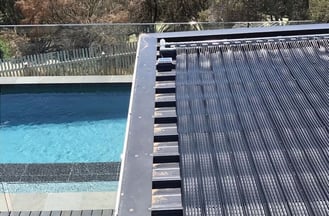
Solar heating can heat your pool water by up to 10°C. The tricky part with solar heating is when you want reliable heating to go swimming in autumn and spring, full sun days are not guaranteed and therefore neither is your heating.
The rule of thumb with pool solar heating is the surface area of your pool is the surface area of tube things you need on your roof. For example, a 8m x 4m pool is 32m2 which means you need 32m2 on your roof as a minimum.
Fully installed costs nationally range between $140 to $170 per m2 for soft plastic tube things (as shown in the image) and $160 and $190 per m2 for rigid plastic tube things. Quality systems have a full 10 year warranty and will automatically circulate water through the system if the tube things on the roof overheat while not in use. There's plenty out there that offer a 15 or 25 year warranty however check the fine print. After 10 years it is usually a prorata warranty.
What about cockatoos? Some systems are promoting rigid plastic tube things as being "cockatoo proof" or with a "10 year cockatoo warranty". Do cockatoos like to dine on the soft plastic roof tube things? Apparently. See many cockatoos around your house? Any cockatoo damage to anything on your house? Live in the country? No to all. You don't need to worry about it and it is more of a marketing approach to move you onto a more expensive rigid system.
This is a topic for another time however a handy combination is solar supplementing. This is where you use a gas heater or heat pump to close the gap between your preferred temperature and the temperature your solar heating is generating. You need a much smaller gas heater or heat pump which also acts as a mechanical backup when the sun isn't shining. For example, solar heating is getting your pool to 23°C and your preferred temperature is 28°C. Your gas heater or heat pump tops up the 5°C to keep the pool at 28°C. 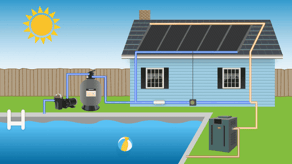
When is it good to use solar heating? If you live in a State that has a pretty high number of sunshine days per year, you'll get the most benefit and may not need anything other than solar heating which is a huge win. If you are in a State that is a little less reliable like Victoria, solar heating might not deliver consistent heating at the temperature you prefer.
Swimming Pool Gas Heaters
A gas heater is just like your instant gas hot water heater at home. Water passes through the internal pipes (heat exchanger) that are exposed to gas flames, rapidly heating the water. A separate pump is needed to suck the water from your pool and return heated water to your pool. Gas heaters run on Natural (mains gas) or bottled Liquid Petroleum Gas (LPG). Make sure you specify this when ordering, as the gas connections are different.
Gas heater size is measured by the megajoule (MJ) input required to heat your pool. Like any heater (inside or out), gas consumption efficiency is 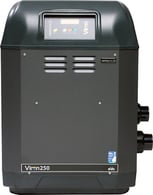 paramount. A cheap heater won’t be efficient and will cost you more with higher gas bills over time so be prepared to pay a little more upfront for cheaper ongoing annual running costs. Quality pool gas heaters have a FULL two-year warranty.
paramount. A cheap heater won’t be efficient and will cost you more with higher gas bills over time so be prepared to pay a little more upfront for cheaper ongoing annual running costs. Quality pool gas heaters have a FULL two-year warranty.
The big advantage of gas heaters is the speed at which they can heat up your pool compared to other options. A gas heater can take your iceberg-laden pool and crank it up to 28°C in 24 to 48 hours in the middle of winter. That sort of performance consumes plenty of gas so be prepared for the gas bill. Once up to temperature, the ongoing cost to maintain your preferred temperature is going to be higher than all other options by some margin as gas heaters don't have an idle mode.
Let's assume you are on mains Natural gas and heating a 8x4m (48,000 litres) fibreglass swimming pool to 28°C in Sydney in October, November, March and April to extend your summer swimming season. Once your pool is up to temperature, with a pool cover, it will cost around $855 per year in consumed gas to keep your pool at 28°C. Without a pool cover, the cost jumps by 140% to $1,832 per year. Reduce the temperature by 2°C to 26°C and your annual gas will drop by around 15%.
The following table shows the massive difference climate makes to the annual heating costs for the same size pool:
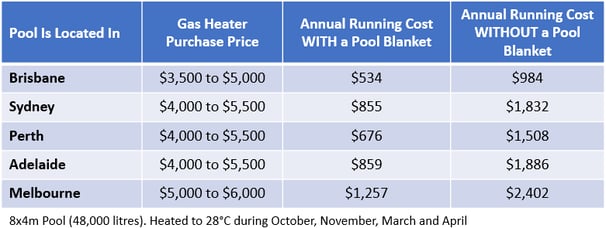
When is it good to use gas heating? If you want year-round heating in colder climates like Victoria or you have a holiday home with a pool and need a fast heat-up time, gas is going to be a good option for you. Gas heaters are excellent for heating spas as they can, in an hour, heat your water up to 38°C which is where many spa users like it. If you are on gas bottles (LPG) rather than mains gas, consider a heat pump as gas heaters consume plenty of gas and LPG is more expensive to buy than mains Natural gas.
Electric Pool Heaters - Heat Pumps
Heat pumps are very similar to your reverse cycle air-conditioning at home. A condenser uses heat from the outside air to generate heat through a heat exchanger. The heat exchanger heats pipes filled with your pool water. Similar to solar, the slower your pool water passes through the heat exchanger the more efficiently your water is heated. It's a good idea to have a separate small heat circulating pump (rather than your big pool pump) to suck water from your pool and push it through the heat pump back to your pool at the slowest speed possible. Heat pumps are awesomely efficient in warm climates with warm ambient air temperature. If the outside air temperature is cool, heat pumps start to lose efficiency however will certainly still get the job done. Gas heaters generally trump heat pumps if you are in southern NSW or Victoria and want to heat in winter for this reason.
Heat pump size is measured by the kilowatt (kW) output required to heat your pool. Heat pumps use inverter technology (the pump speed cycles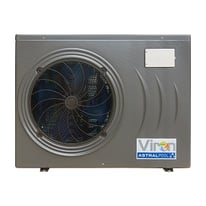 down as the set temperature is achieved) to reduce their running costs. Just like air conditioners, there is a huge difference in the energy efficiency of different brands. This can impact your ongoing running costs by as much as 50%. Stick to quality brands known for their quality and designed for our very unique conditions and have a bundle of independent awards to back it up. (As a note, there are no Australian-manufactured heat pumps. One brand has an Australian flag on the box which could be confused with Australian made. However, it is only assembled in Australia using Chinese-made parts) It is worth paying more for an energy-efficient model upfront as it will save you plenty over the next 5+ years in running costs. What is important with heat pumps is the efficiency of the heat exchanger in cooler weather and the quality of the inverter - stepped or smooth. Sounds like we are talking about stairs and peanut butter however it does make a difference. A smooth inverter is also known as a "full inverter" and uses less power than a stepped inverter.
down as the set temperature is achieved) to reduce their running costs. Just like air conditioners, there is a huge difference in the energy efficiency of different brands. This can impact your ongoing running costs by as much as 50%. Stick to quality brands known for their quality and designed for our very unique conditions and have a bundle of independent awards to back it up. (As a note, there are no Australian-manufactured heat pumps. One brand has an Australian flag on the box which could be confused with Australian made. However, it is only assembled in Australia using Chinese-made parts) It is worth paying more for an energy-efficient model upfront as it will save you plenty over the next 5+ years in running costs. What is important with heat pumps is the efficiency of the heat exchanger in cooler weather and the quality of the inverter - stepped or smooth. Sounds like we are talking about stairs and peanut butter however it does make a difference. A smooth inverter is also known as a "full inverter" and uses less power than a stepped inverter.
The heated water output rate is lower compared to gas, so heating up times are longer with heat pumps. Allow up to 48+ hours for a 12°C increase. The upside is once up to temperature, the cost to maintain that glorious 28°C is 20% or more cheaper than gas.
Let's assume you are using an electric heat pump to heat an 8x4m (48,000 litres) fibreglass swimming pool to 28°C in Sydney in October, November, March and April to extend your summer swimming season. Once your pool is up to temperature, it will cost around $359 per year with a pool blanket assuming you keep your temperature at 28°C. Without a pool cover, the cost jumps by 317% to $1,139. Drop the temperature by 2°C to 26°C and your annual power bill drops by a massive 30%. If you have power generating roof top solar panels, you can cut your annual heat pump running costs by up to 80%.
The following table shows the massive difference climate makes to the annual heating costs for the same size pool:

When is it good to use a heat pump? Water temperature between 26°C and 30°C are where most heat pumps are designed to operate. If you live in a sunny State and have roof top power-generating solar panels, you can potentially heat your pool for next to no ongoing cost. This isn't you? Aside from the slower initial heat up times, once up to temperature, heat pumps are cheaper to run each year than gas. You can also solar supplement using a heat pump in the same way as a gas heater. They can be used pretty much for all purposes other than if you want a quick heat up of a very cold pool at a holiday home or you use heating intermittently through winter.
Pool Heating Calculators
When you are looking at heating options, you will come across brochures with tables that show pool volumes in 10,000-litre increments and the size unit needed in each capital city for the volume of the pool. These are good as a rough indication. However, they are not great if you live 400km away from a capital city. Compared to Sydney, is the weather (and therefore your pool temperature) different in Port Macquarie 400km north of Sydney? Yep. Sure is. Ideally, you (or the company you are buying from) should calculate the heating unit you need based on postcode-specific weather data, use the average depth of your pool (not just litre volume), wind and sun exposure and if you are looking at year-round, extending the season or solar supplementing to get an accurate outcome. I don't know about you, however, but when I am parting with $4,000 on something, basing the decision on a "guestimate" tends to ensure my wallet stays firmly welded shut!
Summary
If you spend $30,000 on a pool and another $4,000 on heating, it is adding 13% to your initial cost. However if that 13% increases your swimming season from 3 months to 6 months (50% more), it's not a bad return if your budget can afford it. Your annual running costs could be as low as $148 or as high as $2,400 so before you choose your heating type and the size of heater you need, answer the following questions -
- Do you want to swim right through winter (higher running costs) or extend the swimming season by a couple of months (more affordable)?
- Do you want to take the chill off with 26°C water temperature (more affordable) or want warmer 30°C water (higher running costs)?
- Is your pool concrete (higher running costs) or fibreglass (more affordable)? Fibreglass pools are typically warmer than concrete. Read more here.
- Is your deep end over 2m deep (higher running costs) or a standard depth of around 1.7m (lower running costs)?
- Do you have a quality pool blanket in conjunction with your heater or are not using a pool blanket (higher running costs)?
- Are you on mains gas (lower running cost )or bottled gas (higher running costs)?
- Do you live in a warmer climate like Queensland (lower running costs) or cooler climates like Victoria (higher running costs)?
- What budget do you have to spend on the annual running costs of your heater?
Quality pool heating suppliers have sizing calculators which will also forecast your annual heating costs BEFORE you buy heating. There should be no surprises when you get your first energy bill. Make sure the calculator takes into account where you live, if you are or are not using a pool blanket and how many hours of sun your pool will be in during the swimming season and wind exposure.
At the end of the day, solar heating is the cheapest option to buy and also operate each year. If you are unsure if solar will keep your pool at your ideal temperature, run your solar system for a full swim season and get a feel for it. Then decide if you will need to top up the water temperature with either a gas heater or heat pump. A heat pump is going to suit the majority of pool owners who want to extend the season, stay within 26°C to 30°C and minimise yearly running costs. If you have a cold spa and realise at 5pm you want a nice toasty 38 C soak by 7pm, a gas heater will be your best friend.
There is some pool equipment you can cut corners and get away with buying cheap if you really have to. This doesn't apply to pool heaters. The old saying "buy cheap, buy twice" is very accurate for pool heating. You might save $900 on the purchase price however spend an additional $1,500 in energy bills over 3 years compared to an initially more expensive, however much more efficient, heater.
Related Blogs
When it comes to backyard swimming pools, fibreglass options often come out on top. They are fast to install, low maintenance, and last for decades. But are they perfect for everyone? Not necessarily.
Thinking about joining the world of fibreglass pools? You might feel like you’ve stumbled into a whole new language of coping, skimmers, gelcoats... What the heck does it all mean?
Thinking about installing your own fibreglass pool in New South Wales? Good on you — done right, DIY pools can save you serious money without cutting quality and still look like a pro job. But....
About The Author
My wife and I grew up playing in swimming pools. Our daughters learnt to swim in our backyard fibreglass swimming pool. There is nothing quite like hearing kids splashing about and giggling. As pools do, our pool became a social magnet for friends, family and neighbours which we loved. Helping customers to have their own pool and saving customers thousands on their pool and equipment is the best job in the world.




















